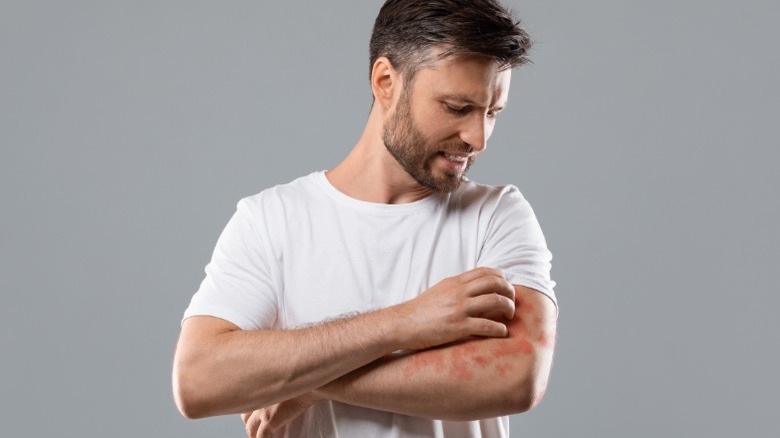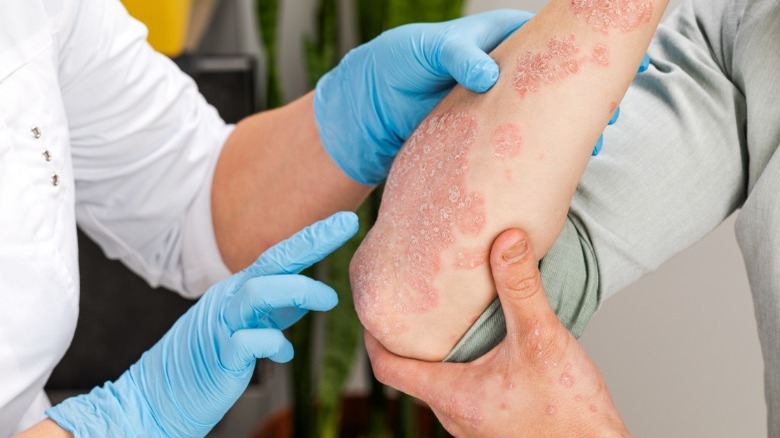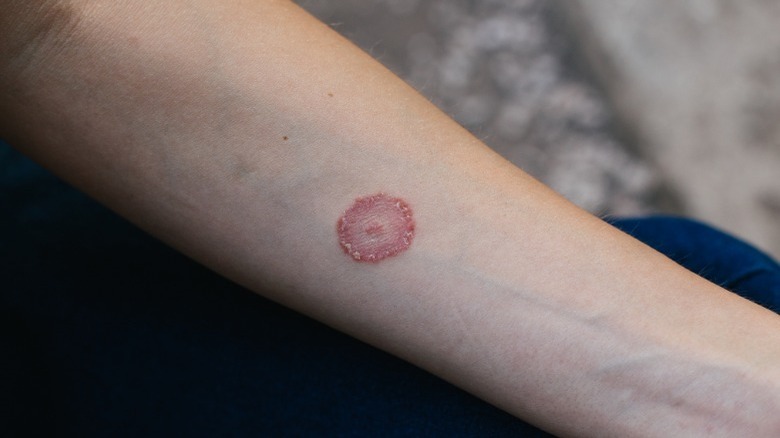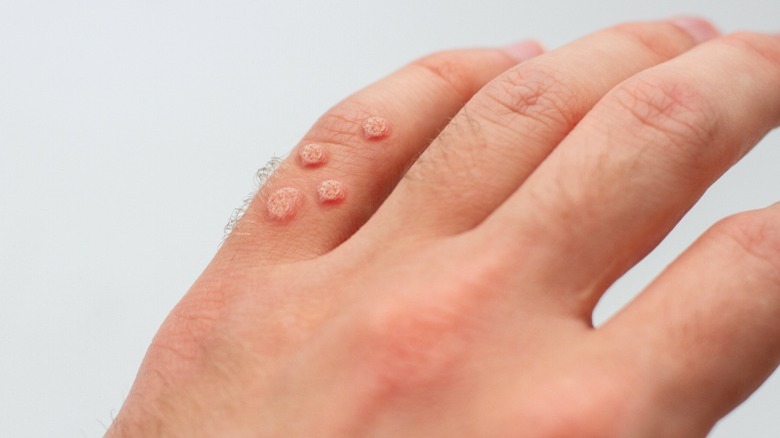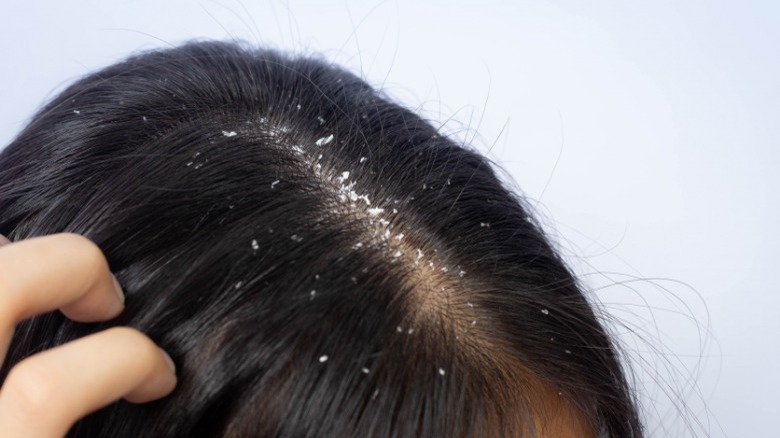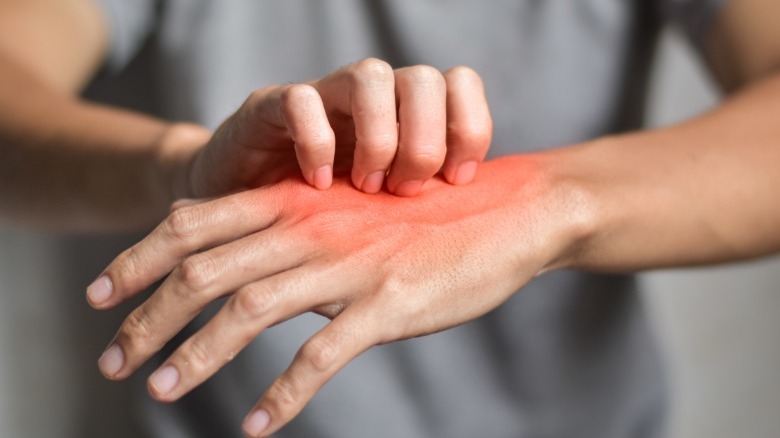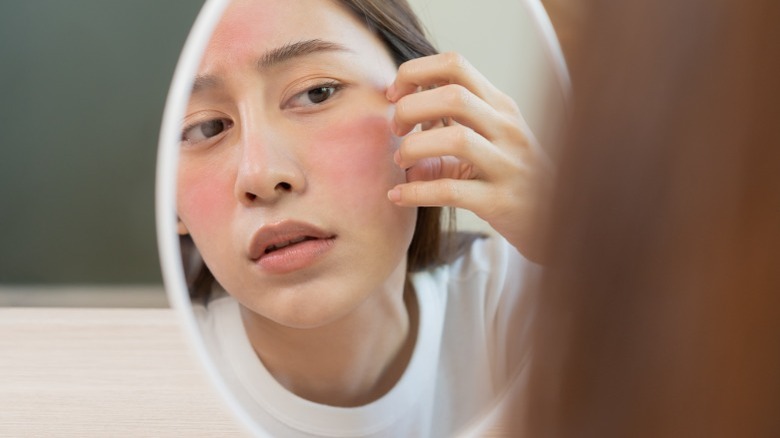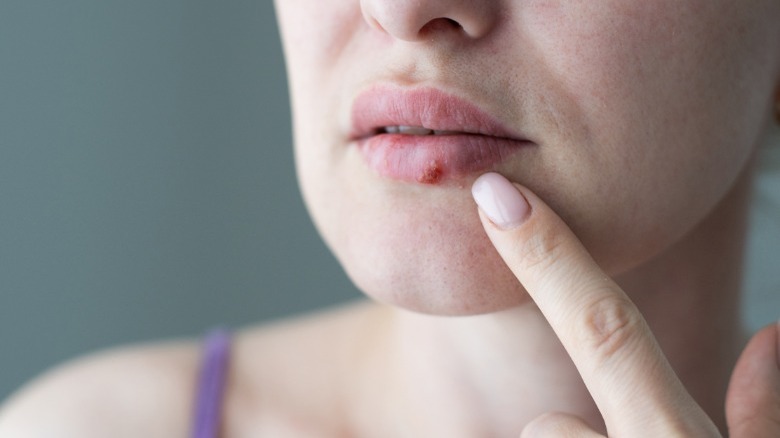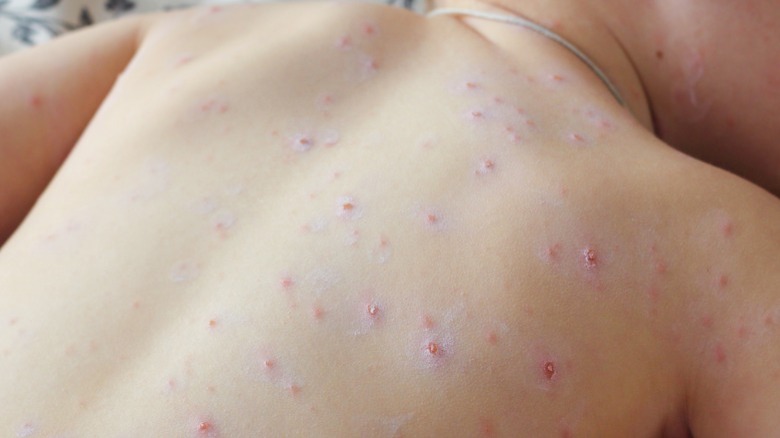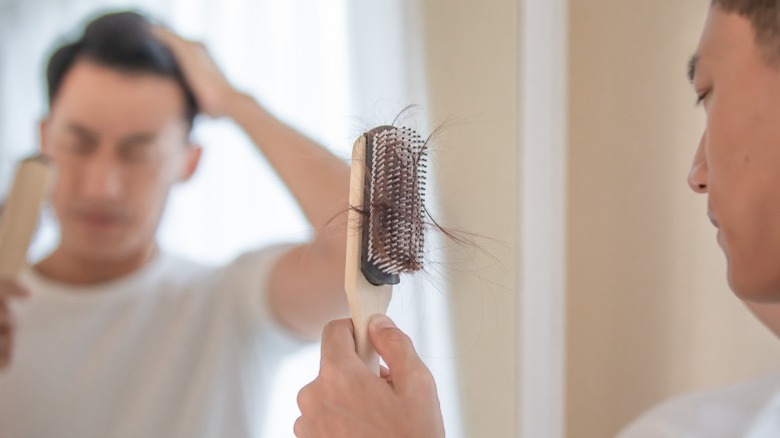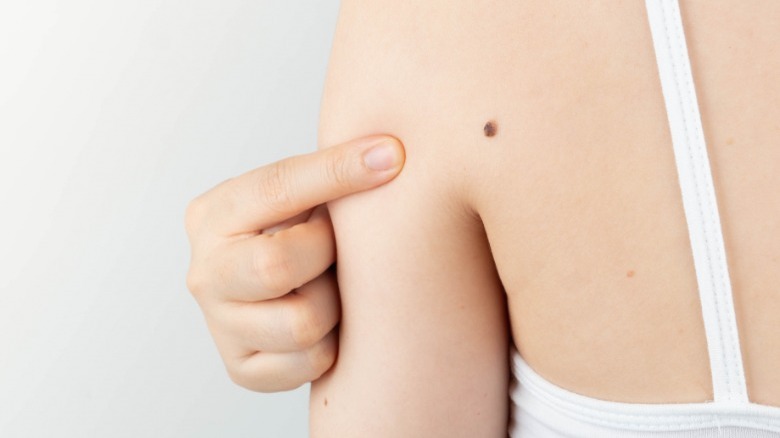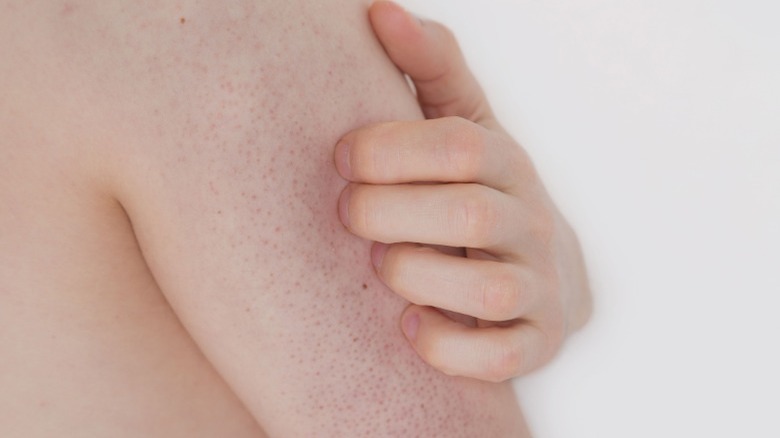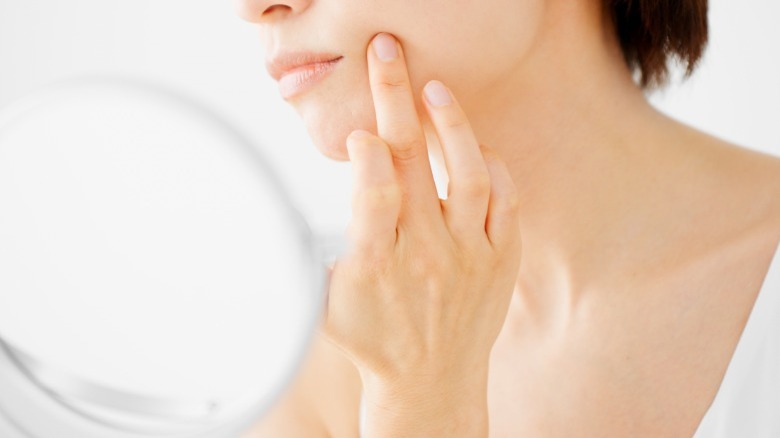Common Skin Problems You Need To Look Out For
If you're one of the many people who deal with skin issues, you're definitely not alone. According to the American Academy of Dermatology Association (AAD), about one in four Americans is impacted by some type of skin disease. Not only are many of these skin problems worrisome, but they can cause uncomfortable and sometimes embarrassing symptoms.
Some skin conditions can even put you at higher risk of developing other health issues, like obesity, anxiety, and depression (via the National Psoriasis Foundation). One study published in the Journal of Dermatology and Skin Science also found that those who suffered from dermatological disorders had lower self-esteem than those who did not experience skin problems.
Because untreated skin conditions can linger or get worse over time, it's always best to talk to your doctor or dermatologist if you notice something is not quite right with your skin. Catching something early could mean quick and easy treatment or managing symptoms you thought you'd just have to cope with for the rest of your life. Here are a few common dermatological problems you should watch for to help you stay on top of your skin health.
Eczema
While there are many causes of dry, itchy skin, eczema may be the culprit if you have a hard time controlling chronic flare-ups. As described by the National Eczema Association (NEA), atopic dermatitis, or eczema, is characterized by dry, scaly patches on the skin that cause itchiness, blisters, and sometimes skin infections. In many cases, these irritated areas will develop in skin creases or behind the knees or elbows where the skin rubs together.
Although researchers are still working on the exact cause of eczema, there are several factors that make this skin condition more likely (per NEA). For one, many eczema patients have an overactive immune system that impacts the skin's ability to retain moisture. Genetics, allergies, and environmental factors also play a role in the development of eczema. If you have family members with eczema or suffer from hay fever or asthma, you're more likely to develop this skin condition (via Mayo Clinic).
The good news is that many cases of eczema are manageable. With the right moisturizers and by avoiding potential triggers that may irritate your skin, you may be able to keep those itchy flare-ups at bay. Discuss your symptoms with your doctor and stick to your recommended care routine to keep your skin looking and feeling its best.
Psoriasis
Psoriasis is another common skin condition that affects more than 3% of the population in the United States (per the National Psoriasis Foundation). This skin disease is caused by inflammation related to overactivity by the immune system, speeding up the development of skin cells and disrupting their natural growth cycle. The skin cells shed much quicker than normal and get trapped underneath the skin, causing scales known as "plaques."
Itchy skin plaques caused by psoriasis are uncomfortable, dry, and often become irritated by scratching. It's also common for people with psoriasis to suffer from related diseases, including psoriatic arthritis, diabetes, and heart disease (via the Centers for Disease Control and Prevention). This is why it's vital to pay attention to your skin and watch for signs of psoriasis to gauge your risk of developing other conditions.
Living with psoriasis comes with its challenges. Apart from the physical symptoms, you may find it difficult to find the right clothing or become socially withdrawn due to symptoms (via the National Psoriasis Foundation). However, with several treatment methods available, you have different options to help calm those painful skin patches and stop flare-ups from occurring.
Ringworm
If you've noticed small circular rashes with raised edges on your arms, legs, or body, you may be dealing with a skin condition known as ringworm. Despite its name, ringworm is not actually caused by a parasite. Ringworm is a fungal infection that results in a scaly, ring-like patch that can resemble the appearance of a worm under the skin, as explained by Healthline. While that may sound rather alarming, it's a relatively common and treatable condition.
So, what causes ringworm? Ringworm occurs when you come into contact with the fungus that causes the condition (via the AAD). Those who play contact sports, are in contact with animals, wear tight clothing, and are overweight are at the highest risk of developing ringworm. Combined with warm, humid conditions, the fungus can grow and spread quickly and start to wreak havoc on your skin.
While ringworm is most common on the body and limbs, it can also thrive on the scalp, in the groin area, under the nails, and on the face (per Healthline). You will notice ring-shaped rashes that are very itchy and may develop blisters with time. When diagnosed with ringworm, your doctor will need to prescribe a special antifungal ointment or spray to kill the fungus and offer recommendations on how to avoid another infection.
Warts
Caused by the human papillomavirus (HPV), warts are small raised bumps on the skin that can be contagious if touched (via Healthline). Some of them appear rounded, while others can be hard and flat against the skin. Although they are generally not life-threatening, warts can spread and cause embarrassing symptoms that may make life uncomfortable.
There are several types of warts that affect different parts of the body, including common warts on the hands, fingers, and toes, plantar warts on the bottoms of the feet, filiform warts around the nose, mouth, and neck, and genital warts that form on and around the genitals. No matter what type of warts you have, they are all caused by one of the hundreds of strains of HPV (per Healthline).
When you choose to ignore warts as a harmless skin condition, you may be putting yourself and others at risk. Warts are contagious and easily spread if a person comes into contact with them. Also, some warts are difficult to treat and can keep coming back even after being removed by a doctor. If you suspect you have warts, it's always a good idea to talk to a healthcare provider to get a diagnosis and start treatment. The earlier you catch them, the more treatment options you'll have available to you (via AAD).
Dry and flaky scalp
An itchy, flaky scalp is an annoying symptom of cold, dry weather. However, it turns out there are more serious cases of dandruff that could have an impact on your everyday routine. Seborrheic dermatitis is an eczema-related skin condition that affects the scalp, causing dry scales and inflamed patches that can leave you with an unbearably itchy head (via Mayo Clinic). These symptoms may also flare up when you're stressed, tired, have hormonal changes, or are exposed to environmental irritants.
When seborrheic dermatitis kicks in, you'll likely experience a very itchy scalp, crusty or oily scales, dandruff flakes, and possible dry patches on the eyebrows, ears, cheeks, and sides of the nose, according to the Mayo Clinic. These symptoms are uncomfortable and disruptive, which can cause you to change your plans and avoid social situations. However, there are steps you can take to relieve the symptoms and treat the condition from home.
The most common treatment for seborrheic dermatitis is medicated shampoo. There are a number of options on the market that contain different active ingredients (via NEA). For example, you may find that shampoos that contain zinc get rid of your dandruff flakes best. For others, shampoos made with tar or salicylic acid may be the only ones that do the trick. In any case, if over-the-counter shampoos don't work, it's time to talk to your doctor.
Scabies
A spreading rash that is intensely itchy and unresponsive to over-the-counter ointments may be a sign that you have scabies (via WebMD). Scabies is a skin infestation of tiny mites that bury themselves and lay eggs under the skin, creating endless irritation and itch. The rash usually starts on the wrists, elbows, knees, between the fingers, and other areas of the skin where there is a fold. It will then continue to spread as the mites lay eggs and create waste in their burrows that irritate the skin.
The red, pimple-like rash caused by scabies is often mistaken for something else because it resembles other skin conditions, including hives or insect bites. However, the itch, particularly at night, will feel much more intense than other issues you may have experienced. You may also notice track marks or longer scrape-looking burrows where the mites dug into the skin.
Remember, these mites are incredibly tiny. Just because you can't see them with the naked eye doesn't mean they're not there! If you have symptoms of scabies, it's crucial to see your doctor and get the right ointment to stop the itch and kill the mites. Scabies will not go away on their own without some intervention (via Cleveland Clinic), so give your skin some love and get to a healthcare professional right away.
Rosacea
Do you blush easily? Are you self-conscious about the skin on your face and neck frequently becoming flushed? This persistent redness may actually be a result of a common skin problem called rosacea. It's estimated that about 14 million Americans have rosacea, a chronic skin condition that typically affects the face, eyes, and neck (via Johns Hopkins Medicine).
While the cause of rosacea is still a mystery, it's more commonly seen in people between the ages of 30 and 60, people with fairer skin colors, and women going through menopause (per John Hopkins Medicine). The main symptom is frequent blushing and flushing of facial skin due to swollen blood vessels. Some people also experience inflammation in the form of pimples or enlarged oil glands on the nose. Others will get redness and tearing in the eyes, which is often accompanied by burning and swelling in the eyelids. In any case, rosacea is certainly not the most discreet skin condition and can cause anxiety and emotional distress, as explained in "Clinical, Cosmetic and Investigational Dermatology" (via Dovepress).
According to the AAD, there are several things you can do to treat rosacea and prevent symptoms from flaring up. For example, you can pay attention to what triggers the blushing and try to avoid them. You can also go hard on sun protection and switch up your skincare habits. Speak with a dermatologist to learn more about skincare for rosacea.
Cold sores
When painful blisters form on and around the lips, you're probably wondering how to get rid of them as quickly as possible. As explained by MedlinePlus, these pesky cold sores, also called oral herpes or fever blisters, are a result of becoming infected with the herpes simplex virus (HSV). The infection usually has to run its course over a week or two before the cold sores start to dry and clear up, but there are some things you can do to help.
WebMD suggests using a cold compress to help with the swelling and discomfort that often comes with cold sores. You can also take over-the-counter pain medicine, such as ibuprofen and acetaminophen, to ease the pain. Other home remedies include using protective balms to keep your lips moisturized, applying alcohol-based ointments to dry out cold sores, and topical painkillers. When those don't work, a visit to your doctor is your next step. The virus that causes cold sores can actually cause serious complications for some people with weakened immune systems or those with eczema (via Cleveland Clinic).
Unfortunately, there is no cure for cold sores (via WebMD). Even after your cold sores clear up, the virus is still in your body and can potentially flare up again. The best ways to prevent cold sores from coming back around are to stay healthy, get enough rest, and avoid direct contact or sharing items with those who have cold sores.
Itchy rash with blisters
Another skin issue you need to be on the lookout for is an itchy rash that forms blisters on the skin. Rashes are never a good sign and often indicate that something is amiss in your body. Whether it be an allergic reaction or a symptom of a viral or bacterial infection, a rash is your skin waving a red flag (via MedlinePlus). In the case of itchy bumps that form blisters, called vesicular rashes, you may be dealing with a case of chickenpox, shingles, or poison ivy (per Verywell Health).
Although chickenpox is not as common now that we have an effective vaccine, it's still possible to become infected with the virus and experience the telltale blister-inducing rash that covers the entire body. The itchy bumps develop fluid-filled vesicles that are very contagious if touched. If you've already had chickenpox, the rash may be a sign that you have shingles from a reactivation of the chickenpox virus. Symptoms are somewhat similar, but the rash usually forms in a band or stripe across the torso (via Verywell Health). The blisters are incredibly itchy and painful and take several days to clear.
Your itchy rash may also be a result of coming into contact with poison ivy or another allergic irritant that causes painful red bumps on the skin. If you've been outside and exposed to plants, you should contact your doctor for some guidance on your next steps.
Hair loss
While some hair loss is slow and happens over time, others may experience a sudden and unexpected thinning of their hair. When your hair falls out abruptly, there may be some cause for concern. As explained by the AAD, one reason for hair loss is alopecia areata, which is an autoimmune disease that causes the body to attack the hair follicles.
Hair loss on the crown of the head is usually the most obvious symptom of alopecia areata. However, hair loss can happen anywhere on the body. Also, those with alopecia tend to have brittle nails that develop ridges and break easily, according to the AAD. The disease tends to start during the adolescent or teenage years. However, about half of patients are able to regrow their hair within a year without any treatment.
If you notice that your hair is falling out quickly or your child experiences sudden hair loss, you should see your doctor or dermatologist as soon as possible. They will be able to diagnose the problem and possibly offer solutions to regrow the hair.
Lupus rash
According to the Lupus Foundation of America, lupus is a chronic autoimmune disease that causes harmful inflammation in different parts of the body. The body's immune system mistakenly identifies healthy tissue as an infection and starts to attack it. The result is swelling, pain, and a slew of other symptoms that may be difficult to diagnose. One of these symptoms is a butterfly-shaped rash that appears on the face over the cheeks and nose.
The official cause of a lupus-induced facial rash is cutaneous lupus erythematosus (CLE), and it affects about two out of every three people who suffer from lupus (via Cleveland Clinic). The skin rash is red and swollen and becomes worse when exposed to ultraviolet light. It's important to identify CLE as soon as possible — about 20% of those who are diagnosed with CLE will also develop systemic lupus erythematosus, which is the type of lupus that is most common.
It's essential to note that not all CLE rashes appear in a butterfly shape or on the face. Some rashes can develop on other areas of skin that get a lot of sunlight, including the arms, chest, and shoulders. In most cases, the rashes appear in a circular shape and come on quickly. However, these rashes are generally not itchy or painful.
Irregular moles
There's a reason our doctors tell us to keep an eye out for irregular moles. According to the Skin Cancer Foundation, atypical moles can increase your risk of developing a dangerous type of skin cancer called melanoma. In fact, individuals with 10 or more irregular-shaped moles have 12 times more risk of melanoma.
But what exactly is an atypical mole? As defined by the National Cancer Institute, an atypical mole generally has irregular borders, uneven colors or the same color as your skin, parts that are raised, and are larger than common moles. These types of moles are not necessarily cancerous. However, they are more likely to develop into melanoma and increase a person's risk of skin cancer in the future.
If you notice an irregular mole that looks different from your other moles, it's always best to get it checked out by a dermatologist. They may want to test the tissue to see if there are any cancer cells present. Also, your doctor may choose to preemptively remove the mole to reduce the chances of the mole developing into melanoma.
Bumps on the back of the arm
You're definitely not alone if you find yourself dealing with small red or brown bumps on the back of your arms. The most common cause of these bumps is keratosis pilaris, which is also known as "chicken skin" due to its textured appearance that resembles raw poultry skin (per Healthline). The hereditary condition happens when dead skin cells become trapped in the pores on your arms and cause a bump that can look like a small pimple. You may also be more prone to these arm bumps if you suffer from other skin issues, including eczema, allergies, or dry skin.
Although keratosis pilaris is not harmful, it can be an annoying eyesore that prevents you from wearing your favorite sleeveless shirts or dresses. If you're struggling with these pesky arm bumps that seem to stick around no matter what, you can talk to your doctor about possible ways to reduce the symptoms. Also, you'll want to get a proper diagnosis to rule out any other dangerous skin conditions.
White spots on the skin
White spots on the skin are another common skin problem that many people experience for different reasons. While they might not be an immediate cause for concern, it's important to get to the bottom of what is causing the discoloration to avoid possible risk factors they may present.
Some people over the age of 50 will develop white spots on their arms and legs called Idiopathic Guttate Hypomelansos, which is mainly a cosmetic issue. However, white spots may also indicate other skin conditions, including milia, pityriasis alba, tinea versicolor, and vitiligo. Some of these issues are connected to genetics, while others are the result of fungal infections or chronic conditions.
The best thing to do if you notice white spots on your skin is to talk to your doctor. A healthcare professional will conduct a full exam to diagnose the issue and make recommendations on how to best care for your skin.

